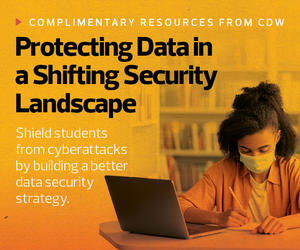2. CoSN Aggregated Cybersecurity Resources
Most the cybersecurity offerings from the Consortium for School Networking — including games, videos and toolkits — are aggregated on a webpage for K–12 IT decision-makers to easily access and share. These resources can help build a better understanding of cybersecurity and give IT leaders a place to start when implementing new security practices in their districts.
Tools are further broken out to guide schools based on the district’s need. There are pages on cybersecurity orientation, planning, implementation and prevention, and response. Each represents a stage of the cybersecurity journey.
3. CoSN Trusted Learning Environment Seal
In addition to its cybersecurity resources for schools, CoSN also has a framework built specifically around data privacy practices in K–12 institutions. The Trusted Learning Environment Seal is awarded to schools that exemplify a commitment to strong student data protections.
To retain their TLE Seal, recipients must show how they are maintaining and improving their data protection policies every two years. According to CoSN’s website, “The TLE Seal Program requirements have been validated by more than 50 school systems.”
District IT leaders can use this framework, and the example set by the seal’s recipients, to improve their own data privacy protections in the areas of leadership, business, data security, classroom and professional development.
UP NEXT: Discover the continued importance of professional development in K–12 education.
4. CISA Online Training Toolkit
Following the passage of the K–12 Cybersecurity Act, the Cybersecurity and Infrastructure Security Agency conducted a 120-day evaluation of the security threats facing districts. The federal agency then had until April 6, 2022 — 60 days after the completion of the risk evaluation — to provide voluntary security recommendations to K–12 schools.
Perhaps the largest requirement of the K–12 Cybersecurity Act is an online training toolkit that CISA must develop by Aug. 4, 2022. The toolkit must be “designed to educate school officials on CISA’s cybersecurity recommendations and provide strategies for its implementation,” according to a news brief from the Crowell & Moring law firm.
All of the resources developed in response to the K–12 Cybersecurity Act will be publicly available on the Department of Homeland Security’s website.
Click here to read this year's list of 30 K–12 IT influencers to follow.













